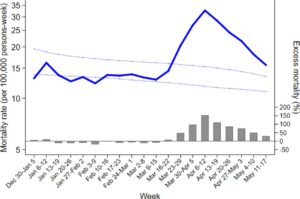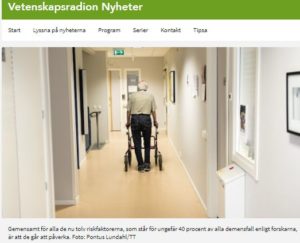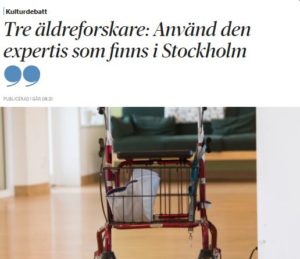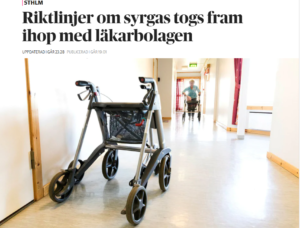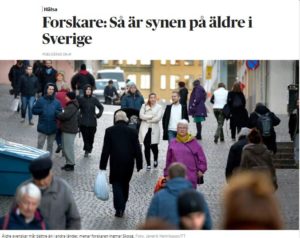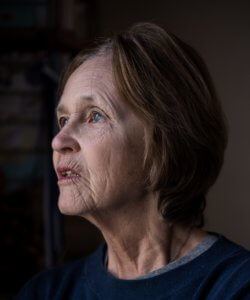
Photo: Ian Gadelius
NEAR-based study explored whether the rate of new cases of dementia has changed from 1987-2013 in persons aged 75 years or over. Two NEAR population-based studies: the Kungsholmen Project (KP; n =1473, 1987-1998) and the Swedish National Study on Aging and Care in Kungsholmen (SNAC-K; n= 1,746, 2001-2013) were used to examine this.
Decline in new cases of dementia by 30% from the 1980s to 2010s
There has been a decline in new cases of dementia in central Stockholm from the 1980s to the 2010s. This trend was especially evident in women and in persons with low education. Improvement in cognitive reserve (i.e., increased education and better working conditions) and cardiovascular health partly explained this decreasing trend.

Photo of Mozhu Ding, first author of the study.
Reference: Ding M, Qiu C, Rizzuto D, Grande G, Fratiglioni L. Tracing temporal trends in dementia incidence over 25 years in central Stockholm, Sweden. Alzheimers Dement. 2020;16(5):770-778. doi: 10.1002/alz.12073.
NEAR-based study explored whether low mood is related to an increased dementia risk and whether marital status and living situation can alter this association. Two NEAR population-based studies: the Kungsholmen Project (KP; n = 1,197) and the Swedish National Study on Aging and Care in Kungsholmen (SNAC-K; n= 1,402) were used to examine this. Low mood was obtained by self-report at the study start and new cases of dementia were collected over 9 years.
Increased dementia risk was found only in those without a partner or who lived alone
Low mood was related to a higher risk of dementia in both studies. However, an increased risk was detected only in those who did not have a partner or lived alone, but not among those who had a partner or lived with someone.
Being married and living with someone can buffer the negative effects of low mood on risk of dementia
Taken together, marital status and living situation have the possibility to buffer the harmful effects of low mood on dementia onset. Specific attention from health care should therefore target persons having low mood and who do not have a partner or live alone.
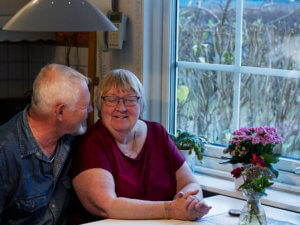
Photo: Linn Fryk
Reference: Sjöberg L, Fratiglioni L, Lövdén M, Wang HX. Low mood and risk of dementia: the role of marital status and living situation. Am J Geriatr Psychiatry. 2020;28(1):33-44. doi: 10.1016/j.jagp.2019.08.014.
The NEAR researcher Johan Skoog, University of Gothenburg, defended his thesis with the title: “Sleep and cognition in old age: Birth cohort differences, dementia, and biomarkers of Alzheimer’s disease”.
The main findings from the thesis imply that 70-year old’s of today have better sleep quality, in terms of insomnia, than 70-year old’s 30 years ago (Do later-born birth cohorts of septuagenarians sleep better? Oxford Academic ). Different types of sleep problems may play varying roles during the life course concerning dementia risk; insomnia could potentially be more important in midlife while waking up too early (terminal insomnia) or long sleep duration (>9 hours) may be more critical later in life (Sleep disturbances and dementia risk: A multicenter study – ScienceDirect). This study included the NEAR databases: H70 and Kungsholmen Project, as well as the Cardiovascular Risk Factors, Aging and Dementia (CAIDE) study, which includes participants from Finland. Finally, sleep may play an important role in the early processes of Alzheimer’s Disease (AD) by potentially decreasing clearance or increasing production of amyloid β that is a biological marker for AD.
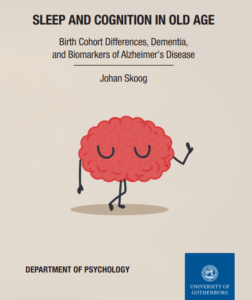
Read more:
God sömn minskar risk för demens | | forskning.se
Bättre sömn motverkar demens hos äldre | SvD
Bättre sömn motverkar demens hos äldre | Aftonbladet
Bättre sömn minskar risken för demens | ETC
“Störd sömn i medelåldern ökar risken för demens” | Kurera.se
Dålig sömn ökar risken för demens | Vårdfokus (vardfokus.se)
Sleep disturbances linked to increased dementia risk | Karolinska Institutet Nyheter (ki.se)
The NEAR Steering Board member and PI of SWEOLD, Carin Lennartsson has been granted funding of 2 500 000 SEK from FORMAS to collect data and research materials linked to the COVID-19 pandemic. The project is entitled “The Swedish Panel Study of Living Conditions of the Oldest Old – SWEOLD COVID-19”.
The project provides a unique opportunity to study changes in several aspects of living conditions, such as physical and mental health, health-related behaviours and social relations. The Swedish Panel Study of Living Conditions of the Oldest Old – SWEOLD will be used to carry out a telephone-based interview study related to the COVID-19 pandemic. Questions directly related to the COVID-19 pandemic will be asked, as well as questions regularly included in the study. An analysis of how older adults have perceived and adhered to the flow of information and specific recommendations will also be conducted.
The NEAR researcher, Therese Rydberg Sterner, presents a summary of her thesis entitled: “Depression among Swedish 70-year olds: Sex differences from a gender perspective” where she found that femininity was associated with a greater burden of depressive symptoms, while androgynity and masculinity were related to a lower burden, irrespective of biological sex . To listen to more of Therese’s research work see the video below.
The areas in the Stockholm region that were the hardest hit by Covid-19 in the early pandemic phase during spring 2020, were characterized by a younger population in combination with lower socioeconomic status. This is shown in an article in British Medical Journal Global Health, by researchers from ARC/NEAR and the Institute of Environmental Medicine, Karolinska Institutet.
The findings can be important in the development of future shielding strategies against future resurgences of the COVID-19 infection or other pandemics.
Read the full article by Amaia Calderón-Larrañaga and coworkers (Open Access)
To hear more about this join the seminar on November 17th entitled: “COVID-19 seminar with Alessandra Marengoni, Amaia Calderón-Larrañaga and Giorgi Beridze” hosted by the Aging Research Center (ARC) using this link: Covid-19 seminar ARC
NEAR’s director Laura Fratiglioni is interviewed on Swedish science radio on newly found risk factors for dementia development that have been pointed out by the members of a commission for the Scientific journal The Lancet. The three factors: alcohol consumption, traumatic brain injury, and air pollution add to an earlier list of nine factors. The twelve risk factors are responsible for around 40% of all dementia occurence.
The newly determined factors can be relieved by change in living habits or stricter legislation.
Read the article in The Lancet
Listen to the interview (in Swedish)
In a cultural opinion article in Dagens Nyheter, signed by NEAR’s Director, Laura Fratiglioni together with two other members of Karolinska Institutet’s special resource group for the health of elderly under the Covid-19 pandemic, urges local authorities to use the their expertise. With more research and education, in cooperation with regional authorities and municipalities, the situation on those nursing homes and facilities lacking in good care can be much improved, they argue.
Read the full article (in Swedish)
In an article in the largest daily newspaper Dagens Nyheter, the professors Anders Wimo (member of the NEAR steering board) and Bengt Winblad (member of the NEAR scientific advisory board) are strongly critical on the guidelines prescribing opioid substances rather than Oxygen treatment för elderly displaying shortness of breath due to Covid-19.
Read the article (in Swedish).
The daily Dagens Nyheter has interviewed two researchers on the societal attitudes towards the elderly in Sweden. Professor Ingmar Skoog, Gothenburg university and member of the NEAR steering board, is surprised over the ‘youth culture’ that is still predominant in Sweden, since today’s elderly are so much healthier and active than before. Media and Journalism associate professor Maria Edström from the same university, notes that people who have retired from working life are much less covered in media. For women, the decline in reporting starts already around 50-55 years of age, she states.
The whole article can be found here (in Swedish).
